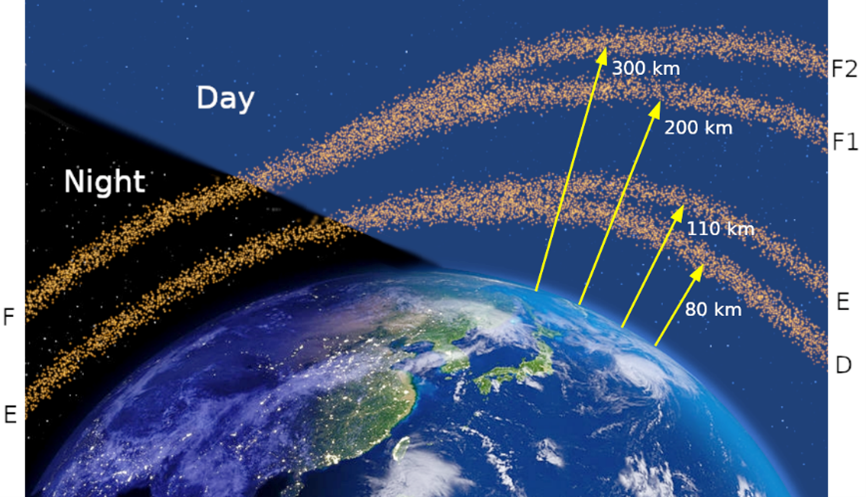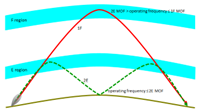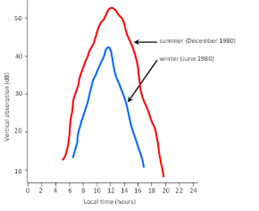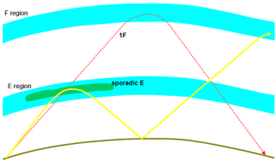Summertime
Operatin’ is easy
Sunspots jumpin’
Your antenna’s up high
The openings switch
Those bands just keep changin’
The regions and seasons
Tell you why
(apologies to George Gershwin and DuBose Heyward)
It seems like just a few weeks ago, the upper HF bands were open all day long to faraway places. At night, the low bands took up the slack, especially as the terminator slid past your location. While we still have plenty of sunspots (thank you, Cycle 25!), the bands are beginning to sound a lot different as summer gets underway. It’s natural to expect that with even more daylight, the upper HF bands should be even more open, so what’s going on? What should we expect during Field Day, which is about a month from now and close to the summer solstice?
Summertime Ionosphere
First, let’s recognize that when we here in the U.S. talk about “summertime,” we’re really just referring to the Northern Hemisphere. The tilt of the Earth’s axis means that the northern ionosphere is illuminated longer and more directly by UV from the Sun. That means its structure will be a little different in the summer than in the winter, and HF propagation will be different too.
Illumination of the ionosphere with UV varies greatly with time of day and the seasons. The phase of the solar cycle also matters, and we are in the rising phase of Cycle 25 during which sunspot activity is increasing. More sunspot activity also increases ionization in all of the regions—D, E, F1, and F2.

(Carlos Molina, CC BY-SA 4.0 <https://creativecommons.org/licenses/by-sa/4.0>, via Wikimedia Commons)
The highest F2 region is what provides long-distance HF propagation, day in and day out, all year long. Its ionization is greatest during daylight hours. The F2 region is strongest during the day and the F1 region below it is mostly a summer daytime region. It appears during the day when solar UV is strongest. The F1 and F2 regions merge at night. Ionization of the lower E and the lowest D regions are also stronger throughout the summer day. The E and F1 regions are responsible for the big shift in HF propagation we observe in the summer.
Blanketing and Absorption
Blanketing (also known as “screening”) refers to a lower region being sufficiently ionized to bend signals heading upward back to Earth before they can reach the higher long-distance regions. For example, the figure below shows how the E region might block signals from reaching either of the F regions. The F1 region sometimes acts the same with respect to the F2 region. It’s as if the lower region placed a blanket over the Earth from the perspective of the upper regions.

From “Introduction to HF Radio Propagation” by the Australian Space Weather Services
The F1 region is primarily a summertime region caused by the extended UV during daylight. The E region is present all year long throughout the day. These two regions work together to block signals headed to the F2 region: the F1 region blankets higher angle signals, and the E region blankets those at lower angles. Either way, the result is a lack of long-distance DX through the day in the summer months.
Absorption occurs as signals travel through a region with strong, dense ionization. This scatters the wave or dissipates its energy as heat. It can occur in the D, E, and F1 regions although it is strongest in the lower regions. The effect is also strongest at lower frequencies.

From “Introduction to HF Radio Propagation” by the Australian Space Weather Services
During the summer, E region and F1 region blanketing and absorption end several hours before sunset. After sunset, the F1 region combines with the F2 region to produce a lower-altitude, less densely ionized nighttime F2 region. The nighttime F region is less densely ionized and has lower MUFs than the daytime F2 region, but it is still there, resulting in long-distance propagation through the summer evenings.
Effects on HF Propagation
The F1 region acts to absorb 20 meter and higher frequency signals through the summer day at high angles. The result is degraded F2 propagation on these bands during midday caused by F1 region absorption and blanketing of F2 propagation. This is especially noticeable in the hours around noon on the upper bands in particular.
Absorption takes its toll on the lower-frequency HF bands through the day. D region absorption rises quickly at sunrise as soon as solar UV can reach the lower regions. Summertime absorption will remain strong on 40 meters until late afternoon, on 80 and 160 meters until sunset, and extends on 160 into the evening. The E region absorbs or blankets 40 meter signals from increased ionization until sunset, extending on 80 and 40 meters into the evening.
Short Skip and Sporadic E
For the higher HF bands, while blanketing and absorption take a significant toll on long-distance F2 propagation, it’s not a lost cause by any means! The blanketing effect produces shorter hops as the signal is returned to Earth, resulting in “short-skip” propagation with a 1,200 to 1,500-mile hop.

From “Introduction to HF Radio Propagation” by the Australian Space Weather Services
For example, this is great for making contacts around the North American continent on the 15, 12, and 10 meter bands. As absorption falls in late afternoon or before it builds up in the morning, 20 and 17 meters benefit as well. There is a lot of day-to-day variability in propagation, so don’t take these guidelines as absolute. There is no experience like calling CQ on a band that you don’t expect to be open and getting a completely surprising contact in return! Use the Reverse Beacon Network and listen for the 10 meter beacon stations to see the actual propagation at the moment.
Sporadic E is another bonus for the summer months. It provides similar propagation to short skip. In fact, the same time is often given to both. True sporadic E or Es is created by wind shear in the E region forming thin layers of dust from meteors and terrestrial events. When the dust is sufficiently dense, it can reflect signals back to Earth with excellent signal strength. The dust is organized as patches or clouds that move with upper-atmosphere winds so the propagation will move with them.
The primary seasons for sporadic E are in May-July and December-January. Sporadic E occurs most commonly during the summer daytime and early evening at low and middle latitudes. At higher latitudes, sporadic E tends to form at night. North America straddles the medium and high latitudes so sporadic E can form during the day and stay active well into the evening. It also forms in conjunction with a disturbed ionosphere following solar activity, so flares and CMEs have some benefits. The clue is that if you hear what sounds like short skip on the higher HF bands, particularly 10 meters, then listen on 6 meters as well. Call CQ and see what happens!
Atmospheric Noise
Along with the summer comes increasing storms that greatly affect the lower HF bands. While the band may be open, the lower signal-to-noise ratio makes communication more difficult. On the lower HF bands, however, blanketing is the same mechanism that creates NVIS propagation, so if the noise is manageable, the signal levels can be stronger.
Don’t forget that northern summer means winter in the southern hemisphere. That creates opportunities for some good low-band DXing when southern stations are benefiting from lower noise levels. This is when noise-rejecting, directional receive antennas really help by cutting down noise from thunderstorms in other directions.
Advice for Field Day
Here is a list of suggestions for Field Day (June 24-25 this year) that can serve as a propagation “template” for your summer months, especially for portable operating of POTA or SOTA. You can also use the information for the worldwide IARU HF Championship that follows two weeks later.
Morning:
- Short skip will be likely on the higher HF bands and 6 meters by mid-morning to late morning
- NVIS will be useful on 40 meters but weaker on 80 meters due to absorption
Afternoon:
- Start looking for 40 meters to open to the east and stronger 20 meter signals
- Before sunset the higher HF bands may open and 20/40 meters will be strong after sunset
Evening:
- 20 meters and even 15 meters may continue to be open for some time to the west
- 40 meters will be open across the continent for quite a few hours
- 80 and 160 meters will come alive a few hours after sunset
Nighttime:
- Depending on solar flux levels, 40 meters may be an excellent band all night
- Your night crew should make the most of 80 and 160 meter activity in your region
Sunrise:
- Look for 20 to 10 meters to open quickly to the east as UV ionizes the F2 region
- The higher bands will degrade as blanketing and absorption build up from the F1 and E regions
- Short skip will develop on the higher HF bands
- NVIS will be useful on 40 and 80 meters, but 80 meters will fade due to absorption
There is so much to HF propagation that every operator, experienced or new, with stations large and small, has something to learn every day, every season, and every year. The ionosphere also has plenty of tricks to play, so get on the air and see what you can hear!
Read all you can on shortwave propagation to learn more—there is a tremendous amount of online material and excellent books to study. Thanks also to Frank Donovan, W3LPL for his helpful presentation, “High Frequency Propagation During the Rising Phase of Cycle 25.” He touches on many topics of interest during this always interesting, sometimes vexing, period as the sunspots return to the solar disk.

